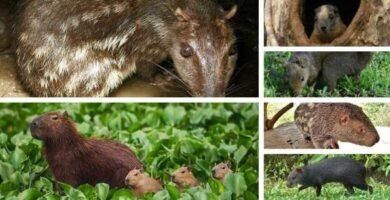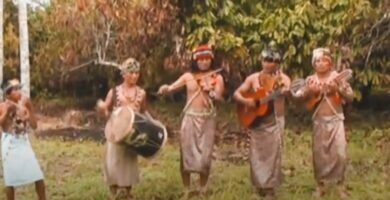They are a practically isolated indigenous people, located in the Amazon region of both Ecuador and Peru. The name Shiwiar can be translated as “hunters and connoisseurs of the jungle”. They are characterized by their rituals accompanied by tobacco, ayahuasca and maikiua, as well as traditional chants, as means of receiving revelations from the spirits (through visions of the past and future of the people), also allowing the healing of diseases based on ancestral medicine.
Mythological origin Shiwiar
From the Shiwiar cosmovision, the supreme being Arutam created the man and the woman; the woman could not give birth and her womb was cut for the child to be born and then she died, therefore it was the man who had breasts and took care of the newborn. One day, to a woman who was pregnant, the man told her to go to the farm to eat peanuts because it was harvest time, and she cried because she knew she was going to die (Gualinga and Santi, 2013)(3).
October 13, 2020

Amazon Rainforest rodents
Suddenly, a rat approached and asked the pregnant woman why she was crying, who replied that her husband was going to operate on her because she could not give birth. The rat told the woman that she was tiny and could give birth, but the woman was big and could not. So, the rat proposed to the woman that he would teach her to give birth, in exchange for half of the aja-chacra of peanuts to feed her young; then the woman accepted, asking not to tell anyone. She then went home and the man was angry when he found her, wondering how she had given birth and, from then on, the man cut off her breasts and placed them on the woman so that she could breastfeed the newborn (Gualinga and Santi, 2013)(3).

76º2’17.79″ W latitude; and 1º58’50.58″ S and 2º6’36.16″ S longitude. Taken from: Gualinga Wisuma, E. and Santi Machoa, I. 2013. Analysis of the mathematical knowledge of the Shiwiar nationality of Ecuador. Cuenca: University of Cuenca. Retrieved from http://dspace.ucuenca.edu.ec/bitstream/123456789/20065/1/monografía.pdf. (3)
Territory and population
The Shiwiar are located southeast of the province of Pastaza, in the Ecuadorian Amazon. They have traditionally inhabited the territories corresponding to the upper basins of the Corrientes and Tigre rivers, reaching the border area with Peru called the “national security strip” (CONAIE, 2014)(1).
The Shiwiar population is estimated at 1,200 people, distributed mainly in nine dispersed communities: Kurintsa (parish head); Tunguintsa; Cambantsa; Panintza; Chuintza; Tanguntza; Juyuintza; Pientza and Bufeo (Indigenous Territory and Governance, 2021) (6).
Beliefs and main rituals Shiwiar
From the Shiwiar‘s cosmovision , as in other Amazonian indigenous communities, the spirits are found everywhere; jungle, farms, rivers, lagoons, etc. Indeed, the shamans or wishin of this ethnic group use tobacco(Nicotiana tabacum), ayahuasca(Banisteriopsis sp.) and maikiua (floripondio, Brugmansia sp.) to have visions in which Arutam appears to them in various forms, such as jaguar, boa, heavy rains, winds or even in the form of the spirit of a person. In the various spiritual rituals, these Indians exhibit facial paintings and ornament their bodies with necklaces, crowns, feathers and carry the spear as a symbol of their warrior tradition (Republic of Ecuador, Ministry of Education, n.d.)(5).
December 9, 2021

Kichwa music from the Amazon-Ecuador
Natemamau
The Shiwiar celebrate the Natemamau ceremony in which the whole family participates to receive the power of Arutam. 15 days before the beginning of this ritual, the Tuntui -large drum, two and a half meters long- an instrument typical of this indigenous culture. These aborigines play the Tuntui and spend three or four days fasting, singing and consuming ayahuasca to strengthen their relationship with the spirits. On the other hand, the Shiwiar ask for abundance in the hunt to Amasan, who is the God of wild animals and plants , as well as good fishing to Tsungui who is the God of all animals living in aquatic spaces (Republic of Ecuador, Ministry of Education, n.d.) (5).
Housing
Most Shiwiar families continue to build their traditional houses using guambula wood ( Minquartia guianensis ) for the foundations and canelo (Ocotea spp.) for the beams that support the roof. The roof frame is made of guadua cane (Bamboo, Guadua angustifolia), covered with leaves of pambil (Iriartea deltoidea), turuji (Hyospatha tessmannii) or chapi (Phytelephas macrocarpa ) (NASHIE, 2007) (4).

Marriage
Today, the practice of polygamy among the Shiwiar has been almost completely abandoned. Men of this ethnic group usually chooseShiwiar women to marry, but it is increasingly common for them to choose women of other nationalities, among them Kichwa and Achuar . Marriages must be accepted by the families of both spouses, so the bride and groom spend some time living in the bride’s family home and then some time living in the man’s family home; once the families agree to the marriage, the bride and groom can move into their own home (NASHIE, 2007).4).
Language
The main language of these Amerindians is Shiwiar Chicham. Some older adults in this Amazonian indigenous community speak Kichwa, but very few speak Spanish due to little contact with the outside world. However, the new generations are often trilingual(Shiwiar Chicham, Kichwa and Spanish) (CODENPE, 2003)(2).
Subsistence economy
The Shiwiar ‘s family economy is subsistence based, based on agriculture (farm production) along with hunting, fishing and gathering wild fruits, as in other Amazonian indigenous peoples.
In addition to these traditional activities, they have added the sale of handicrafts (canoes, tools, spears, bodoqueras, pottery, musical instruments, basketry, jewelry, among others) and tourism activities to obtain monetary income. According to the Ministry of Education of Ecuador (n.d.), one of the most purchased objects by tourists are hunting tools such as bodoqueras -batanas with darts and a container with curare- decorated with designs of the Shiwiar nationality. Also noteworthy are the Tiyam-Pijuano flutes, characteristic instruments of this indigenous nationality, made of cane or bone, based on ancestral knowledge.
References
- Confederation of Indigenous Nationalities of Ecuador, CONAIE. 2014. Shiwiar. Retrieved from https://conaie.org/2014/07/19/shiwiar/.
- Council for the Development of Nationalities, CODENPE. 2003. Indigenous nationality. Amazonia. Retrieved from https://web.archive.org/web/20080801110620/http://www.codenpe.gov.ec/shiwiar.htm.
- Gualinga Wisuma, E. and Santi Machoa, I. 2013. Analysis of the mathematical knowledge of the Shiwiar nationality of Ecuador. Cuenca: University of Cuenca. Retrieved from http://dspace.ucuenca.edu.ec/bitstream/123456789/20065/1/monografía.pdf.
- Nationality Shiwiar of Ecuador, NASHIE. 2007. Shiwiar-Ecuador. Retrieved from https://web.archive.org/web/20080427144952/http://www.shiwiar-ecuador.org/index.html.
- Republic of Ecuador, Ministry of Education. S.f. Primer of knowledge, wisdoms and ancestral knowledge. Nationality Shiwiar. Retrieved from https://www.educacionbilingue.gob.ec/wp-content/uploads/2021/01/CARTILLA-SHIWIAR-ZONA-3_compressed.pdf
- Indigenous Territory and Governance. 2021. Shiwiar. Retrieved from https://www.territorioindigenaygobernanza.com/web/necu_09/.

Economist (Central University of Venezuela). Full professor and researcher attached to the “Edgar Abreu Olivo” Agrifood Research Center, Universidad de Los Andes. Doctor from the University of La Laguna (Spain). Award “One of the 10 most consulted authors of the Saber ULA university portal” (2005); prize in the III Essay Contest of the Central Bank of Venezuela BCvoz Economico, 2016, with the work “Theobroma cacao: transformation and consumption of the “food of the gods” in Venezuela and the world” (co-authored).
This post is also available in:
![]() Español (Spanish)
Español (Spanish)
